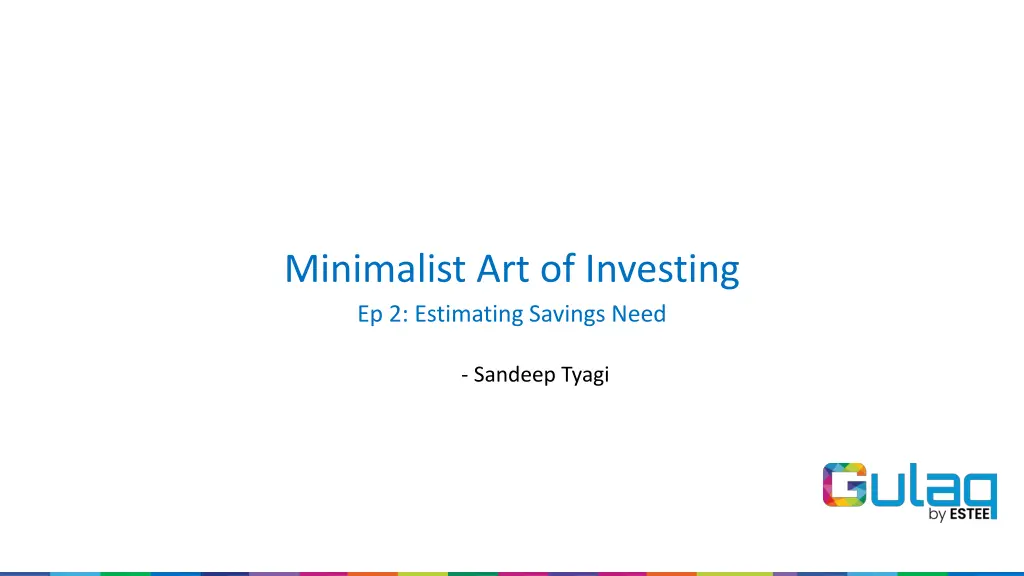
Estimating Savings Need: Assessing Financial Goals
"Learn how to assess savings for investment goals through the story of Rajat, a young professional facing new financial obligations. Understand the importance of accurately estimating expenses and savings to achieve financial security. Discover key insights on setting realistic investment plans and avoiding common pitfalls in financial planning."
Download Presentation

Please find below an Image/Link to download the presentation.
The content on the website is provided AS IS for your information and personal use only. It may not be sold, licensed, or shared on other websites without obtaining consent from the author. If you encounter any issues during the download, it is possible that the publisher has removed the file from their server.
You are allowed to download the files provided on this website for personal or commercial use, subject to the condition that they are used lawfully. All files are the property of their respective owners.
The content on the website is provided AS IS for your information and personal use only. It may not be sold, licensed, or shared on other websites without obtaining consent from the author.
E N D
Presentation Transcript
Minimalist Art of Investing Ep 2: Estimating Savings Need - Sandeep Tyagi
Recap: Setting Returns Expectations 60-40 portfolio 10-year Rolling Returns Chances of making money increases as the holding period increases Debt Allocation 40% On an average Sensex gave 11.4% returns (CAGR) over 10-years rolling returns Equity Allocation 60% The FD returns average is at 8.2% Negative Return Years 0 Over 40 years, 11.4% returns will generate 75X of initial investment, and 8.2% will generate 23X Average Return 10.76% Best Year Return 16.04% A 60-40 portfolio is a simple plan to start with Worst Year Return 3.95%
Do not save what is left after spending, but spend what is left after saving - Warren Buffet
Assessing savings This is a story of someone I know-Rajat. He is thirty years old and recently married. They are expecting their first child in 4 months. Rajat earns INR 12 lacs a year and lives with his parents. He wants to move out into an independent apartment. He recently bought a new car. The car was a little more expensive than he felt comfortable with, but he got a car loan through his bank. What do you see as the investment and savings plan for Rajat? He is living beyond his current means, and adding to his obligations (new baby, larger home, loan payment).
Why to assess savings? Over optimistic investors Tend to save little for investment goals. As a result, they are likely to fall short of their requirement. Over pessimistic investors Tend to save too much for the goals. As a result, they are likely to face financial stress and sacrifice present for the future. Overconfidence in future earnings, underestimating future expenses, and not assessing savings need are key reasons behind poor investment planning
Step by step process to estimate expenses Income Expenses = savings Collect 13 months of your main bank account statement Fill the balances for each month in the template Identify all outflows which went into asset creation as asset purchase Template link is provided on Gulaq.com, Live webinar page Identify all inflows as either income or asset sale You have 5 numbers for each month now Balance at the beginning of the month (B1) Asset purchase (P), Income (I), Asset Sale (S) Balance at the end of the month (B2) Expense (E) = B1 + I + S P B2 Add expenses of all months for yearly expenses estimation Savings potential = I + P S E
Savings Rate In 2021, Average savings rate in India is? a) 28% b) 16% c) 44% d) 35%
Savings Rate Trend In 2021, the average savings rate is 28%, down from 36% in 2011 Normal savings rate is between 25 to 40% If its below this range, you should think if your expenses are for a good reason or not
Three Big Savings Goals Buying a Home Covered Today Retirement Will be covered in next session Kids Education Will be covered in next session
Investment Plan for Buying a home
Buying Home vs Renting House Buying a Home vs Renting a house is one of the most common debates in personal finance. What do you think is a better option? a) Buying a Home b) Renting a House c) No idea!
Buying Home vs Renting House Buying Home Renting House Building an Asset Lower rent compared to EMI Tax benefits No down payment, Less Asset appreciation financial stress Emotional security Location flexibility Liquidity issue Rental growth Expensive Outflows even after retirement EMI Burden One less Asset
Buying a Home vs Renting a house A 3-BHK flat in Bangalore costs 1.2 Crores. 40% down payment, 72 Lakhs home loan, 8% Interest, 20 Years duration EMI of 60,000 Total amount repaid 1.44 Crores, including interest of 72 Lakhs The cost of taking a loan is equal to the loan itself!
Buying a Home vs Renting a House Buying a Home Renting House 36,000 Rent/Month, Rental growth 6% annually A 3-BHK flat in Bangalore costs 1.2 Crores. In 20 years, 1.58 Crores rent paid 40% down payment, 8% Interest, 20 Years Difference of EMI and Rent is invested at 10.46% EMI of 60,000. Total repaid 1.44 Crores 48 Lakhs of down payment invested at 10.46% Appreciation of 6% Net value of 3.86 Crores at the end of 20 years Asset value 3.85 Crores at Loan closure Net value will continue to be invested Net value of 2.53 Crores Continue paying higher rents No need to pay EMIs anymore
Buying vs Renting Major factors Investment returns An investment in FD vs 60-40 portfolio. Ex: In case of Renting, FD investing would make investment 1.9 Cr vs 3.86 Cr if invested in 60-40 portfolio Asset appreciation Even a Slight change in appreciation impacts asset value a lot in 20 years. Ex: 7% appreciation would make owning a house more favourable, and a 5% appreciation would not really do so.
Buying Home vs Renting House What is the Tax deduction limit on Home loan interest paid? a) 50,000 b) 1,00,000 c) 2,00,000 d) 3,50,000
Buying a Home While planning to buy a home, one should consider 4 Key factors Income, Home loan duration, downpayment, and EMI 3 20 30 40 Rule Price of home shouldn t be more than 3X of your current annual income Home loan duration 20 years EMI shouldn t be more than 30% of your monthly income Downpayment of 40%
Investment plan to Buy a Home Chanchal Kumar wants to buy a home in Delhi. He figured out that he would need a fully furnished 3-BHK flat for his family. The flat is available at INR 1.2 Crores. He has 30 Lakhs savings. His salary is 25 LPA, and his wife s is 20 LPA. Check 3 20 30 40 rule Everything satisfies except for 40% downpayment value Chanchal should invest his savings, and add a SIP to reach quickly 48 Lakhs downpayment As 60-40 would be a stable portfolio, he can invest in it Once the investment value reaches 48 Lakhs, he can take a home loan for 72 Lakhs The EMI of 60,000 has to be accounted for in his future expenses
Templates used in this Episode Template to estimate savings 1. Template to estimate savings 2. Template to assess Buying a home vs Renting a house
Coming Episode Planning your Retirement
Thank You F O LLO W U S O N Sandeep Tyagi GULAQ LinkedIn: https://www.linkedin.com/in/styagi/ LinkedIn: https://www.linkedin.com/in/gulaqnew Twitter: https://twitter.com/styagi Twitter: https://twitter.com/gulaqfintech Instagram: https://www.instagram.com/gulaqfintech/






















